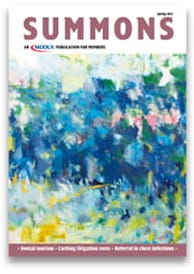THE renowned human geneticist, Julia Bell, was born and schooled in Nottingham, where her father was a printer and bookseller. She had nine older and three younger siblings, most of whom survived to adulthood. Julia grew up amid the hurly-burly of home life and the sound of music being played. Photographs show a slim young woman with a cloud of fine blonde hair.
Her intelligence and diligence earned her a place at Girton College Cambridge where she read mathematics. Illness prevented her from sitting the final examinations but her noted ability earned her a rare aegrotat. Discrimination against women in Cambridge forced her and others to travel to Trinity College, Dublin to graduate. There she was awarded BA and MA in 1907.
Julia was enthralled by the beauty of mathematics and the power of statistics and for the next six years as a postgraduate she provided the mathematical know-how that physicists lacked. She conducted studies on solar parallax at the Cambridge Observatory and also performed calculations on the physics of the earth’s crust.
At Girton, Julia had heard lectures by Professor Karl Pearson, who was an applied mathematician at University College London and director of the Galton Laboratory for National Eugenics. Pearson actively encouraged social and intellectual equality among men and women and sought bright young women from Girton to assist him. Thus Julia came to London to start a lifelong career in genetics. In London she also joined the suffragette marches.
A key researcher in genetics was JBS Haldane. Studies in Dropsophila had yielded genetic charts but the lower genetic variation and poorly defined chromosomes made similar studies in mammals difficult. He bravely attempted a search for human genetic linkage. He enlisted the skills of Julia Bell and together they demonstrated linkage between haemophilia and colour-blindness and published their findings in 1915.
Peter S. Harper comments: “The paper is a marvellous example of thoroughness, detailed mathematical skill in maximising information from the data, and foresight in defining general principles that would determine the pattern of research for the next 40 years. It combines clarity with mathematical rigour… a model of how to study linkage for any genetic character or disorder.”
As Julia grew more interested in observing family characteristics, Pearson encouraged her to study medicine. She qualified with the MRCP LRCP in 1920 from the London School of Medicine for Women (later renamed the Royal Free) and St Mary’s Hospital and practised one day a week for the next decade of her life. She was awarded membership of the Royal College of Physicians in 1926 and elected FRCP in 1938. In 1932 she served on the genetics committee of the MRC and between 1933 and 34 was a permanent member of the MRC scientific staff.
From 1908-14 Bell had honed the use of statistics in a series of investigations on heredity as interpreted by Pearson. She now began to make important contributions to a large project at the Galton Laboratory to record pedigrees of human hereditary disease and unusual features. It was published in five volumes between 1909 and 1958 as The Treasury of Human Inheritance. The monographs by her on hereditary diseases of the eye (1922-33), nervous diseases and muscular dystrophies (1934-48, with J Purdon Martin and Arnold Carmichael) had clear introductions and were headed with literary quotations that showed her empathy with patients.
Data on brachydactyly occurring in a family in Wales was the source for an important section contributed by Bell in volume V (1951-3) on digital anomalies. She also contributed studies of the Lawrence-Moon syndrome to that volume. Studies of an English family in which low intelligence was inherited as an Xlinked trait and therefore produced an excess of retarded males was published in 1943, yielding the term Martin-Bell syndrome. A “fragile site” can now be demonstrated on the X-chromosome.
Aged 62 Julia received the Weldon memorial prize and medal for biometry from Oxford University. Her interests were wide – the subject of one early paper was the long bones of the English skeleton, another was on oral temperature in school children with special reference to parental environment and class difference. Her last paper, published in the BMJ when she was 80, was on rubella in pregnancy. Her final years were spent at St George’s Nursing Home where she died aged 100 years.
Sources:
• Julia Bell. Greta Jones In: Dictionary of National Biography. Oxford University Press
• Landmarks in medical genetics. Ed. Peter S Harper. Oxford 2004
• Karl Pearson some aspects of his life and work. ES Pearson. Cambridge University Press 1938
• Julia Bell MRCS, LRCP, FRCP (1879-1979) Steamboat Lady, statistician and geneticist. Sarah Bundy. Journal of Medical Biography. Julia Merrick is a freelance writer and editor in Edinburgh
From Summons Spring 2012, p 23
Summons Spring 2012
Click here for PDF of this issue of Summons
This page was correct at the time of publication. Any guidance is intended as general guidance for members only. If you are a member and need specific advice relating to your own circumstances, please contact one of our advisers.
Read more from this issue of Insight

Save this article
Save this article to a list of favourite articles which members can access in their account.
Save to library